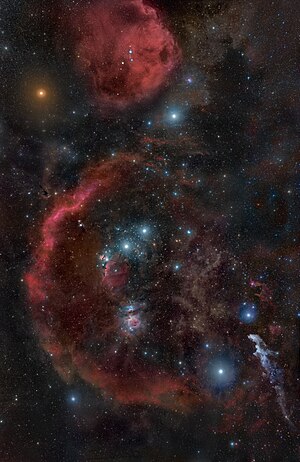Betelgeuse


Betelgeuse (from Arabic: إبط الجوزاء Ibṭ al-Jauzā’, meaning "the armpit of Orion") is a large red supergiant star in the Orion constellation. It is usually the ninth-brightest star in the night sky, and the second-brightest in Orion.
Betelgeuse is a semiregular variable star whose apparent magnitude varies between 0.2 and 1.2.[1] This is the widest range of any first-magnitude star.
It is also one of the largest and most luminous observable stars. It has a radius between around 640 times wider than the Sun's radius.[2] This means it is around 900 million kilometers in diameter. Betelgeuse was the first star other than the Sun whose size was known. The star's distance from Earth is between 400 and 500[3] light-years. Its average absolute magnitude is about −6.02.[4]
Betelgeuse is less than 10 million years old. It evolves rapidly because of its high mass.[5] It is moving through the interstellar medium at a speed of 30 km/s, creating a shock wave over 4 light-years wide.
Betelgeuse is now in a later stage of stellar evolution. It will rapidly go through its life cycle before exploding as a type II supernova sometime in the next million years. Betelgeuse was once a yellow supergiant, which was observed by humans thousands of years ago.[3]
An observation by the Herschel Space Observatory in January 2013 showed that the star's winds are crashing against the surrounding interstellar medium.[6] Betelgeuse is one of the red supergiant stars to have a bow shock: others are Mu Cephei and IRC-10414. Betelgeuse can be seen at the upper left in Orion.
Alternate names
[change | change source]Betelgeuse is also called Alpha Orionis (α Orionis, abbreviated Alpha Ori, α Ori).
Related pages
[change | change source]- Orion (constellation)
- Rigel
- 119 Tauri, Antares, and Mu Cephei, other similar red supergiant stars
References
[change | change source]- ↑ Davis, Kate (AAVSO Technical Assistant, Web) 2000. Variable star of the month: Alpha Orionis. American Association of Variable Star Observers (AAVSO). [1]
- ↑ Mittag, M.; Schröder, K.-P.; Perdelwitz, V.; Jack, D.; Schmitt, J. H. M. M. (January 2023). "Chromospheric activity and photospheric variation of $\alpha$ Ori during the great dimming event in 2020". Astronomy & Astrophysics. 669: A9. arXiv:2211.04967. doi:10.1051/0004-6361/202244924. ISSN 0004-6361.
- ↑ 3.0 3.1 https://academic.oup.com/mnras/article/516/1/693/6651563
- ↑ Harper, Graham M. et al. 2008. A new VLA-Hipparcos distance to Betelgeuse and its implications. The Astronomical Journal 135 (4): 1430–40. [2]
- ↑ Levesque E.M. 2010. The physical properties of red supergiants. Astronomical Society of the Pacific. 425 Hot and Cool: Bridging Gaps in Massive Star Evolution ASP Conference Series: 103. [3]
- ↑ "Betelgeuse braces for a collision". ESA. 2013-01-22. Retrieved 2013-01-23.